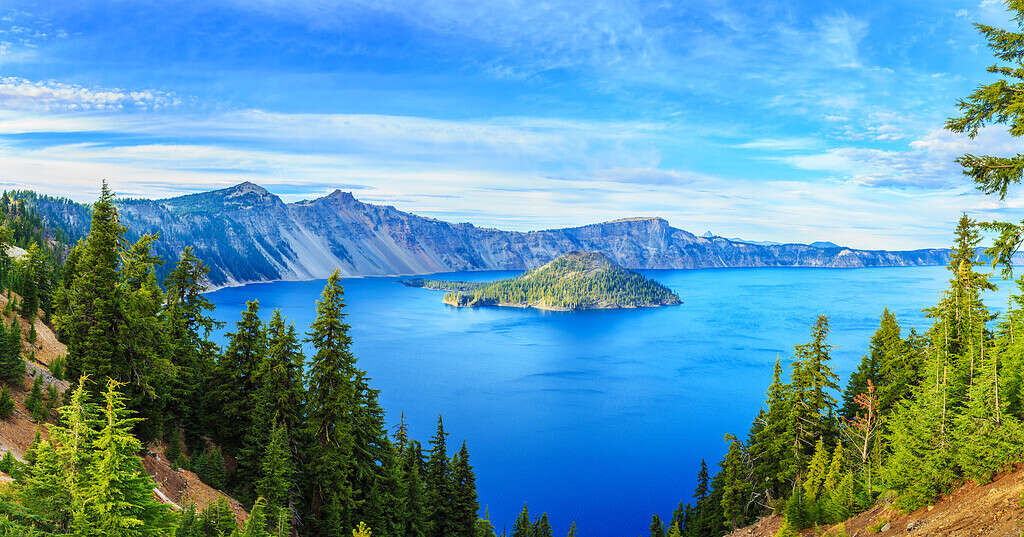Tucked away in the stunning national forests of South-central Oregon, Crater Lake sits on the crest of the Cascade Mountain range, just 100 miles east of the Pacific Ocean. This lake is not your average body of water, as it lies within a caldera that formed over 7,000 years ago.
Out of the 1,400 names lakes in Oregon, Crater Lake stands out from the rest due to its location, water clarity, and impressive depth. Which leads to the question, just how deep is Crater Lake? Keep reading to discover its depth, location, what makes it special, and how it formed.
How Deep is Crater Lake?

With a maximum depth of nearly 2,000 feet, Crater Lake is the deepest lake in the United States
©iStock.com/Photographer and videographer from Ukraine
Crater Lake has an average depth of 1,148 feet and a max depth of 1,949 feet, making it the deepest lake in the United States, the second-deepest in North America, and the 9th-deepest in the world. But compared to other lakes with basins above sea level, Crater Lake is the deepest. And it partly fills a 2,148-foot volcanic crater.
This incredible deep lake is six miles long and five miles wide, with a nearly 22-mile shoreline. And it is the showstopper of Crater Lake National Park, which draws half a million people each year for swimming, boating, fishing, camping, and hiking. The lake also features two islands, one near the western shore and the other near the southern shore.
Crater Lake is recreationally and geologically important and holds a sacred significance to the Native American Klamath tribe.
Where is Crater Lake Located on a Map?
Crater Lake National Park does not have a physical street address, so it can be challenging to navigate the area. But modern GPS systems can get you close. Be sure to look for the Rim Village Visitor Center, which will get you close to the lake.
Geographically, Crater Lake is in Southwest Oregon, north of Medford and Klamath Falls and south of Eugene and Bend. Crater Lake National Park is right next to Umpqua National Forest and just north of Upper Klamath Lake and National Wildlife Refuge. Rim Village is three miles north of the Park Headquarters. Here, you can check out the Rim Visitor Center as the historic Kiser Studio.
Be sure to check for road closures before visiting.
How Did Crater Lake Form?
The quickest way to describe the formation of Crater Lake is the phrase “Grew, blew, fell, and fill.” This simple phrase highlights the life of Mount Mazama, a complex volcano that grew for half a million years before violently erupting around 7,700 years ago. After its explosive eruption, Mount Mazama collapsed into itself and slowly filled with snow and rain, eventually creating Crater Lake.
Mount Mazama is considered a dormant volcano that could likely be active again in the future. According to the United States Geological Survey, “Future eruptions will likely occur within the caldera and probably beneath the water’s surface. The interaction of magma and water may produce explosive eruptions that send tephra and large rock fragments out of the caldera.”

Crater Lake is the clearest and cleanest lake in the world
©Wollertz/Shutterstock.com
What is Crater Lake Known For?
Apart from being the deepest lake in the United States and one of the deepest in the world, Crater Lake is well known for its vibrant blue color and pristine water clarity. Because of its volcanic location, no rivers flow in or out of the lake. The only water that leaves is through evaporation and seepage, and the only water it replaces is through rain and snowfall.
This cycle of evaporation and replenishment ensures the lake’s water is entirely replaced every 250 years. Crater Lake is the cleanest and clearest lake in the world. Its lack of rivers and streams means there are no pollutants or sediments that get into the water. To keep its water pure, the park prohibits the use of water gear, boats, and pets.
Animals Around Crater Lake
There is no doubt that Crater Lake is a special and unique place in our world. And the wildlife that lives in and surrounds its waters are equally unique.
Taking a trip to Crater Lake National Park, you may see coyotes, elk, mule deer, black-tailed deer, mountain lions, and black bears in the surrounding wilderness. But you can also find smaller creatures, like frogs, snakes, porcupines, insects, and many birds. Because of its impressive depth, you may be wondering if anything lives at the bottom of this pristine lake. Colonies of moss and bacteria thrive at the bottom of Crater Lake. You can learn more about the bottom of Crater Lake by reading this article.
Crater Lake National Park is a beautiful wilderness destination filled with wondrous sights and plenty of recreational opportunities. But like any wild area, you must be on the lookout for potentially dangerous wildlife. Black bears, mountain lions, and rattlesnakes are the animals you should pay attention to the most. Always keep your distance, stay on the marked paths, and always let others know where you will be.
The photo featured at the top of this post is © Pung/Shutterstock.com
Thank you for reading! Have some feedback for us? Contact the AZ Animals editorial team.







